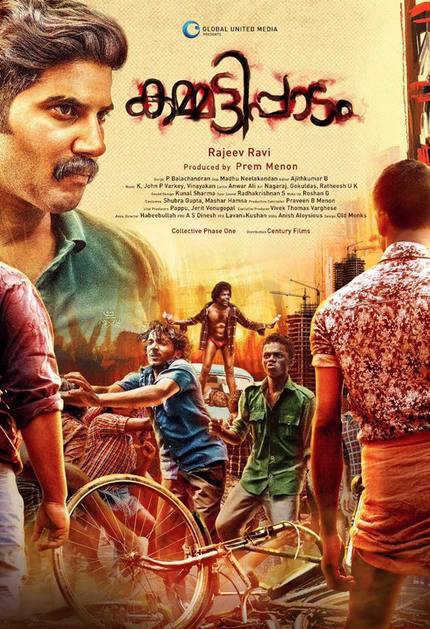Review: KAMMATIPAADAM, Once Upon A Time In God's Own Country

India loves a good gangster film. While the many regional film industries are very different in a lot of ways, almost all of them count the gangster film as a staple of every cinema hall. Most of these films function as a sort of escapism for audiences, yet they work largely because they hit very close to home and are relatable in any part of the country.
Rajeev Ravi's new crime epic Kammatipaadam is the latest entry into an already strong oeuvre of Indian gangster films and it is the best example of the genre since Anurag Kashyap's Gangs of Wasseypur. A little bit Godfather Part 2, a little bit Once Upon a Time in America, and a little bit Wasseypur, Kammatipaadam traces the rise and fall of a mid-level gangster in the titular small slum in Kerala, India.
Krishnan works at a security firm in Mumbai. One day, his daily routine of guarding precious gems and Bollywood film sets from gawkers is interrupted by a phone call from an old friend named Ganga. He is in trouble and needs Krishnan's help, so the dutiful compatriot begins the trek back to Kammatipaadam as a flood of memories recount his early years and a life of crime on the outskirts of urban Kochi. Through a series of staggered flashbacks, we learn of Krishnan's past, the history of modern Kammatipaadam, and of the lives of its low level hoodlums.
On its face, Kammatipaadam is a rather run of the mill story with a bit of flash in the story telling department, but don't be mistaken, this is an exceptional film that better defines its characters better than any in recent memory.
Kammatipaadam tells a story spanning 40 years. From Krishnan and Ganga's youth as children of poverty in the slums, through to their rise as small time hoods and enforcers under the guidance of Ganga's older brother Balan. The story of Kammatipaadam is the story of India, one of rapid growth outpacing the ability of the nation to adapt, creating vacuums of power just waiting to be filled by unscrupulous men. These men, the ones who truly gain from the ignominious deeds of men like Krishnan, are largely out of sight, but it isn't their story that Kammatipaadam is telling. It is the story of the foundation on which the throne of corruption is built, and a thrilling story it is.
Krishnan, Ganga, and Balan are the fulcrum around which Kammatipaadam revolves, and their lives are beautiful in their refusal to balance with expectation. With any film the onus of responsibility generally sits on the head of the director to make something worth your time, but with Kammatipadaam, Rajeev Ravi has wisely created a world in which his characters beg for your attention in even the most menial of motions. Rajeev Ravi's world building is exceptional, and enlisting one of Malayalam cinema's best actors in the search of a truly transcendant experience was a master stroke on his part.
As Kammatipaadam takes place over several generations, it utilizes several performers to embody the central character of Krishnan. The one performer most central to depicting the character is Dulquer Salman who brings the baggage of being the next generation of Malayalam hero to bear in the film. Dulquer is one of Mollywood's most famous performers, his biggest role to date is that of Aditya in Mani Ratnam's OK Kanmani, and in Kammatipaadam it is easy to see why. His performance as the unbridled, violent, ecstatic Krishnan is a thing of beauty. He embodies the enthusiasm of a young man discovering his own power over those less bold than he, while at the same time allowing Krishnan's moral confusion space to breathe just below the surface.
More than once when watching Kammatipaadam I was reminded of the great mafia films of Martin Scorsese. From his depiction of the down in the dirt small time hoods in Mean Streets, all the way through to the scheming big shots of Goodfellas and Casino, what binds the work of Scorsese is an obsessive attention to character, and that attention is what truly sets Kammatipaadam apart. Rajeev Ravi gives his audience complete, well-rounded characters they can latch onto. In spite of their outward brutality and violence, Ravi gives each of these men lives, loves, and challenges of their own without detracting from the central story.
It is with the kind of confidence that comes from years of study behind the camera that Ravi frames his own film, taking lessons from the masters and expanding on them. Ravi is a frequent collaborator of Anurag Kashyap, having served as cinematographer on six of his previous features, and it is clear that he was doing more than simply framing those films, he was paying close attention. Ravi's Kammatipaadam is the result of translating what he's learned on those films into a new language, both literal and cinematic, and creating a world in which the villains can be heroes if you just squint hard enough
At a hair shy of three hours, it might seem that Kammatipaadam could be an endurance trial for all but the most dedicated of film fans. However, the film never feels overlong or indulgent, and I'd have happily spent another three hours with these characters in this world. In fact, there is word that a four hour version of the film exists, and that knowledge has me chomping at the bit to dig further into the world of Krishnan and company. For my money, Kammatipaadam is the best crime film out of India so far this year and I'm looking forward to whatever Rajeev Ravi and Dulquer Salman cook up next.







